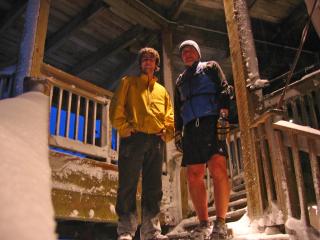
Another privacy spat has erupted in relation to Facebook, the social networking site. It all began when the site began actively advertising everything you did you all of your friends: every time a photo was updated or a relationship status changed, everyone could see it by default, rather than having to go looking. After that, it emerged that Facebook was selling information to third parties. Now, it seems that the applications people can install are getting access to more of their information than is required for them to operate, allowing the writers of such applications to collect and sell information such as the stated hometown and sexual orientation of anyone using them.
Normally, I am in favour of mechanisms to protect privacy and sympathetic to the fact that technology makes that harder to achieve. Facebook, I think, is different. As with a personal site, everything being posted is being intentionally put into the public domain. Those who think they have privacy on Facebook are being deluded and those who act as though information posted there is private are being foolish. The company should be more open about both facts, but I think they are within their rights to sell the information they are collecting.
The best advice for Facebook users is to keep the information posted trivial, and maintain the awareness that whatever finds its way online is likely to remain in someone’s records forever.
[Update: 12 February 2008] Canada’s Privacy Comissioner has a blog. It might be interesting reading for people concerned with such matters.
Something strange is happening to undersea fiber optic cables in the Middle East: they are being cut. At least four, and possibly five, of the communications links have failed in the last twelve days. The first two were allegedly damaged by a ship’s anchor; subsequent failures are more mysterious. Serious disruptions are being experienced in Egypt and India, along with lesser problems in Bahrain, Bangladesh, Kuwait, the Maldives, Pakistan, Qatar, Saudi Arabia and the United Arab Emirates. The fifth cable cut seems to have disabled internet access in Iran.
It’s tempting to ascribe some nefarious motive to all of this. That said, it is sensible to recall how past hysterias proved unjustified. After much hoopla in the media, it turned out that the ‘cyberwar’ against Estonia was the work of a twenty year old subsequently fined $1,620 for his misdeeds.
The cable problems are being widely discussed:
[Update: 16 February 2008] According to The Economist, all this was just hysteria.

With existing technology, it is entirely possible to build houses that allow their owners to be dramatically more energy aware. For instance, it would be relatively easy to build electrical sockets connected to a house network. It could then be possible to see graphically or numerically how much power is being drawn by each socket. It would also be easy to isolate the energy use of major appliances – furnaces, dish washers, refrigerators – thus allowing people to make more intelligent choices about the use and possible replacement of such devices. In an extreme case, you could have a constantly updating spreadsheet identifying every use of power, the level being drawn, the cost associated, and historical patterns of usage.
Being able to manage electrical usage through a web interface could also be very helpful. People could transfer some of their use of power to low-demand times of the day. They could also lower the temperature in houses and have it rise in time to be comfortable by the time they got home. Such controls would also be very useful to people who have some sort of home generating capacity, such as an array of solar panels. A web interface could provide real-time information on the level of energy being produced and the quantity stored.
While all of these things are entirely possible, there do seem to be two big barriers to implementation. The first is in convincing people to install such systems in new houses or while retrofitting houses. The second is to make the systems intuitive enough that non-technical people can use them pretty well. The first of those obstacles would be partially overcome through building codes and carbon pricing. The second is mostly a matter of designing good interfaces. Perhaps an Apple iHome is in order.
Bruce Schneier, the security guru and internet sensation, has been suggesting that people unlock their wireless networks. Given the constant and well-justified anxiety that exists about computer security, it is unconventional advice. That said, he argues effectively that the risks are fairly limited and that it is a neighbourly thing to do. Who hasn’t benefitted once or twice from the availability of an open wireless network? They were invaluable during my early weeks in Ottawa: allowing me to access Craiglist, Google Maps, and other vital apartment-hunting data while I was out there searching.
I am going to try leaving my wireless network open for a couple of weeks. If it doesn’t seem likely to burst my 200GB monthly bandwidth cap, I will leave it that way indefinitely. Hopefully, it will transpire that others have done the same when I start hunting around for a quieter flat in a more interesting neighbourhood this spring.
Partly because of concerns about archiving digital files in the long term, I am hoping to make prints from some of my digital files. Unfortunately, there is an issue of aspect ratios. My digital photos all have an aspect ratio of 4:3 – different from those used for 4 x 6″, 5 x 7″, and 8 x 10″ photographic prints. I don’t especially want black bands on two sides of each image, and I definitely don’t want them arbitrarily cropped.
Is there anywhere online where I can order digital prints on photographic paper in native digital resolution? Albums capable of holding prints with that aspect ratio would also be required. The alternative – manually cropping hundreds of photos to minimize the unwanted aesthetic effects of switching to the 4 x 6″ format – is something I only want to do as a last resort.
A comic in which Emily’s artistic talents have been combined with my egregious printing is now on her beanhead site. It is also mentioned on her blog. Tristan has produced a video about the whole beanhead phenomenon, featuring exclusive footage of Emily and I walking around in Vancouver’s Chinatown and inventing silly answers to silly questions.

Some people are predicting that 2008 will be the year when the internet slows down. The cause is expected to be massive amounts of video traffic, partially driven by social networking sites. All those voice-over-internet phone calls will naturally add to the flow of packets that need to be routed around the world.
All this makes me wonder whether it might be better to allow a bit more discrimination in routing. Sending and receiving video is fun, but rarely essential. Having the more prosaic uses of the internet suffer unduly because of such things seems improper. I could probably surf text all day using the bandwidth required to watch a few minutes of television online.
I don’t really know enough about internet architecture to be able to say whether such filtering could be accomplished, whether it would be cheated very easily, or whether it would cause additional problems. That said, you can certainly expect such questions to get asked more often if predictions of slowly loading websites and jerky video calls prove correct.




